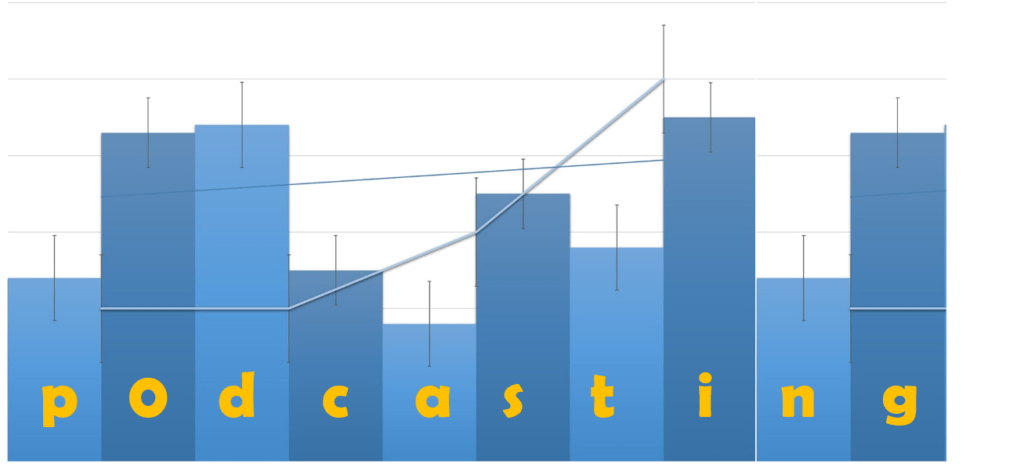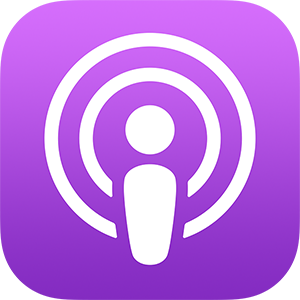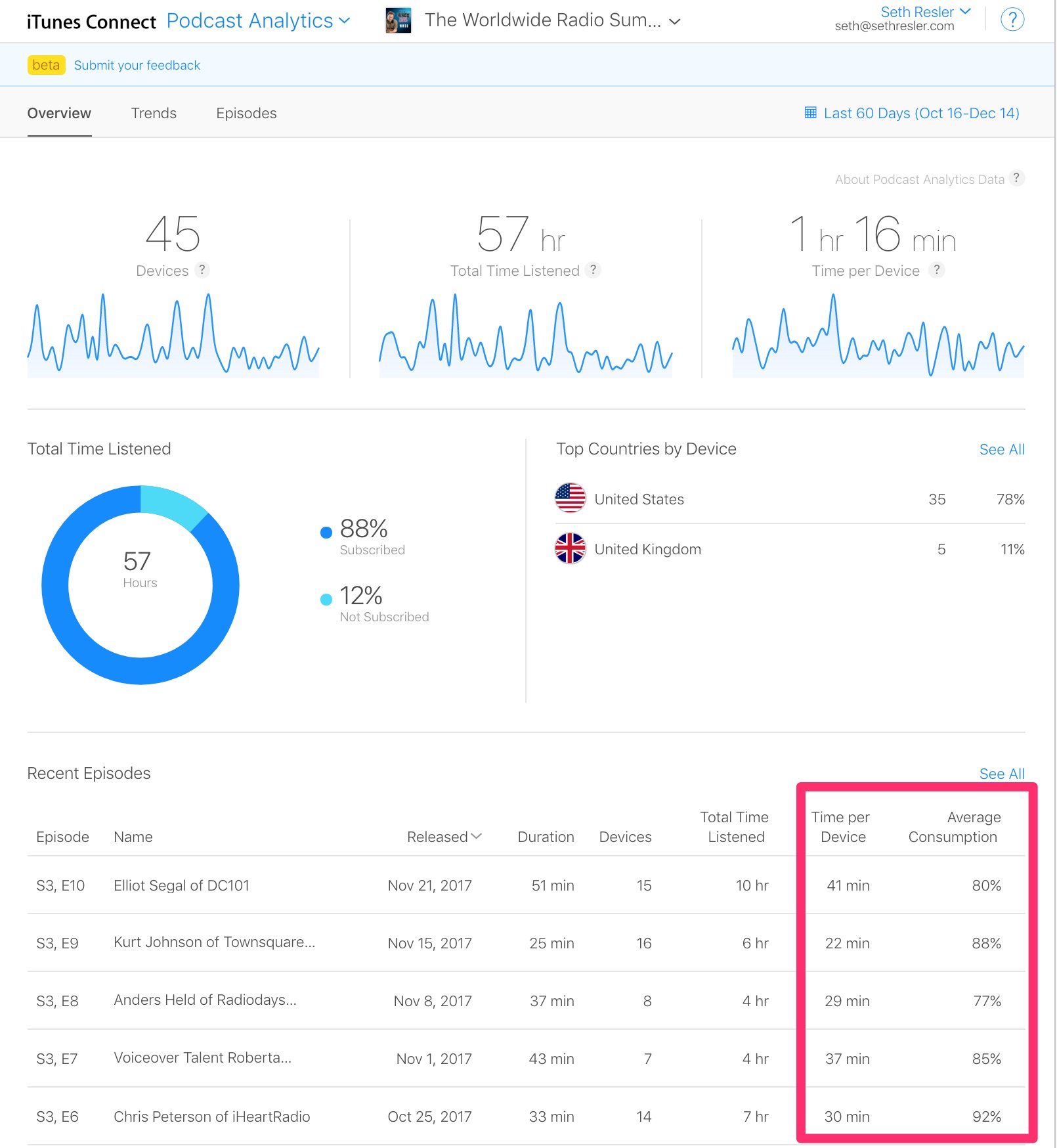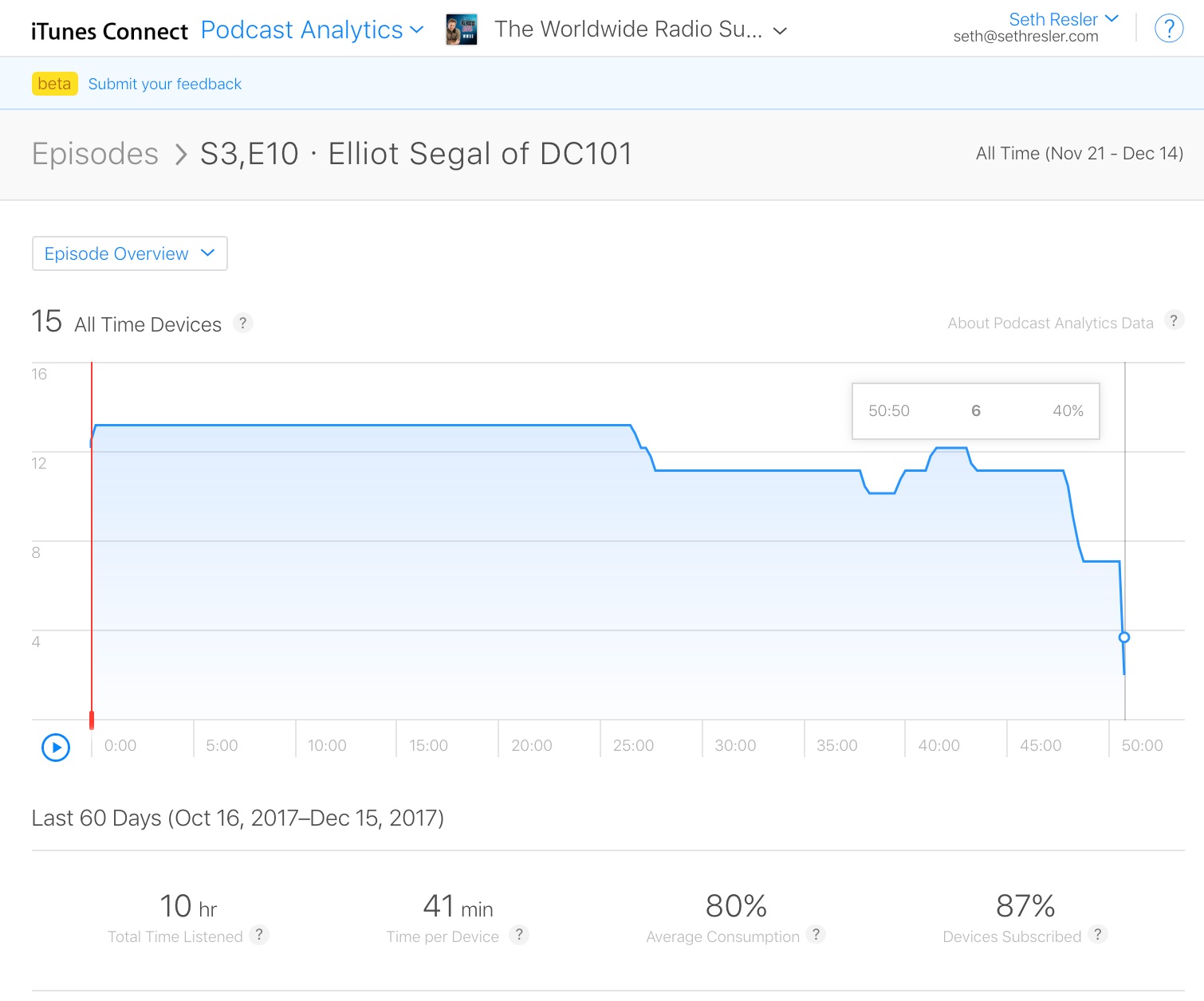 There’s been much debate about why podcasting hasn’t become more mass appeal. Some point to podcast discovery – a topic we covered in some depth in this blog last week. Others believe it’s the number of steps many have to go through in order to listen to podcasts. Still others say the name “podcasting” is misleading and confusing.
There’s been much debate about why podcasting hasn’t become more mass appeal. Some point to podcast discovery – a topic we covered in some depth in this blog last week. Others believe it’s the number of steps many have to go through in order to listen to podcasts. Still others say the name “podcasting” is misleading and confusing.
But part of the explanation is definitely due to a lack of reliable, accepted metrics that shed light on who’s listening, when, where, and for how long. It’s been said you can’t monetize content you cannot measure, and that applies directly to podcasting. But late last week, Apple finally released their long-awaited-for analytics.
And our Digital Dot Connector, Seth Resler, jumped on his Mac and started doing some serious number-crunching. Here’s a first look at how Apple’s data stacks up and what this may mean to podcast producers and marketers. – FJ
Analytics in the podcasting medium are changing, and it impacts everyone in the space. Unlike in the radio industry which has Nielsen, podcasting has no third party company tallying up all podcast listeners and publishing ratings for advertisers to use when allocating their marketing dollars. Instead, each podcaster gets their data from their hosting company — the place where the podcast audio files reside.
So if your podcast is hosted on AudioBoom, and you want to sell a sponsorship to Acme Auto Parts, you have to print up the stats from the back-end of your AudioBoom account and give them to Acme. To ensure they know what they’re getting, Acme may even require you get a letter from AudioBoom certifying the accuracy of your stats, just to make sure you didn’t Photoshop in some inflated numbers.
 The key unit when measuring podcasts is “downloads.” But what if Acme is trying to compare a podcast that hosts with Spreaker to a podcast that hosts with Omny Studio? Sure, it could get stats from both hosting companies, but how does it know what counts as a “download” on one platform is the same as what counts as a “download” on the other?
The key unit when measuring podcasts is “downloads.” But what if Acme is trying to compare a podcast that hosts with Spreaker to a podcast that hosts with Omny Studio? Sure, it could get stats from both hosting companies, but how does it know what counts as a “download” on one platform is the same as what counts as a “download” on the other?
In short, how does the advertiser know they’re comparing apples to apples when looking at the numbers from two different companies?
For years now, the IAB (Internet Advertising Bureau) has been working with key players in the space to build consensus around podcast stats to address this issue. Last week, they issued Version 2.0 of their IAB Podcast Measurement Technical Guidelines. Soon, advertisers will be able to trust that all podcast measurements from IAB compliant hosting companies are on the same page. (The IAB isn’t running its compliance program yet, but it’s coming.)
Some podcast hosting companies have had to adjust their measurement reporting to bring them in line with the IAB. As a result of this new adherence to tighter standards, some podcasters have seen a drop in their download numbers. In the short run, this is disappointing. In the long run, this is good for all podcasters because it will make advertisers more confident about spending money in the podcasting space. It’s a sign that the podcasting world is maturing.
But there was an even bigger development in the world of podcasting analytics last week. In the radio industry, one of the most important metrics we measure is “Time Spent Listening.” Unfortunately, there has been no equivalent measurement in the podcasting world. You may know if a podcast episode was downloaded, but that doesn’t tell you how much of the episode was actually listened to (if it was listened to at all!).
The reason we’re missing this metric is because while the audio files for a podcast reside with a hosting service, people listen to podcasts on apps called “podcatchers,” such as Stitcher, Overcast, or Pocketcasts. For a podcast hosting company to report how much of an episode was listened to, they would need to get data from these podcatchers.
By far, the biggest podcatcher is the Apple Podcasts app that comes pre-installed on every new iPhone. It is also native to the Apple CarPlay interface in many new cars, ensuring Apple’s dominance in the space. And our research shows a key listening location for podcasts is while people are driving.
Android phones, on the other hand, don’t come with a  native podcatcher which is another factor that’s stunted podcasting’s growth. To listen to a podcast on an Android device, you first have to download a podcatcher.
native podcatcher which is another factor that’s stunted podcasting’s growth. To listen to a podcast on an Android device, you first have to download a podcatcher.
This extra step has a huge impact on podcast listening. In fact, Apple Podcasts (and iTunes) accounts for approximately two thirds of all podcast downloads, leaving all other podcatchers in the dust. Unfortunately, Apple has not shared its data with podcast hosting companies, so there’s been no way to figure out TSL for the vast majority of podcast downloads.
That is, until now.
At the Worldwide Developers Conference earlier this year, Apple announced it would introduce Podcast Analytics, a back-end where podcasters can log in and see data for their podcasts. For months, podcasters have been eagerly awaiting this data. Last week, Apple finally rolled out the Beta version of Podcast Analytics, and it’s been a hot topic in the podcast community over the weekend.
Here are some first impressions using my Worldwide Radio Summit podcast I’ve produced the past few years at Joel Denver’s and Sat Bisla’s event in L.A. each spring. Keep in mind, this is one podcast. But there are insights here we’ve not seen before in the podcasting ecosphere.
1. Time Spent Listening (or “Average Consumption” Rate) is High…
Apple uses the term “Average Consumption,” which expresses the amount of an episode that people listen to as a percentage. Many of us podcasters feared Apple’s analytics might show a ton of podcast listeners who check out a podcast for a few minutes and then drop off. In fact, among the podcasters that I have heard from, the Average Consumption looks really solid – often over 80%. That is true for most of the episodes of the Worldwide Radio Summit podcasts:

Perhaps because podcast fans are active, not passive, listeners — that is, they have to jump through a few hoops to seek out and play a podcast episode — they are more likely to listen to a larger percentage of the episodes. On the radio, you most typically aren’t seeking out specific content (this is why benchmarks are so important). So, when you randomly punch up a station, you may not be that invested in what you’re hearing. Hence, those 10 minute PPM average “listening occasions” that make PDs nuts.
This data doesn’t really answer the podcast length question but it’s insightful nonetheless. For a long time, people have been trying to determine the optimal duration of a podcast. This data suggest the answer may be, as many experts in the field have said, it depends on the quality of your content. Consumers will listen to a long podcast…if it’s good.
Hopefully Apple will compile the data and release some benchmark numbers so podcasters can measure themselves against others. I’d love to get some answers to these questions:
- Do shorter podcast episodes have a higher Average Consumption rate than longer podcast episodes?
- Do podcasts see a dropoff around the time of the average commute length?
- Do podcast listeners skip pre-roll or midroll ads?
In the future, we may get answers to these questions…and more.

2. …Maybe Too High
I was surprised to see the podcast episode featuring my interview with former Jacobs Media social media superstar Lori Lewis has an Average Consumption rate of 125%. How is that even possible? Many other podcasters are also reporting seeing numbers that exceed 100%. What does that mean?
So far, I haven’t heard a definitive answer, though many are speculating it may mean the same listener is going back and listening to an episode twice, or rewinding and listening to a portion of an episode over again. Podcasters will be looking for Apple to offer some clarification here.
3. Measuring Devices, Not Listeners
Apple is tracking unique devices, but it only provides anonymous aggregate data. Interestingly, it uses the term “Devices,” not “Listeners.” Radio Futurologist James Cridland pointed out this could be problematic. In radio, we sometimes have one radio that reaches multiple listeners, such as a radio in an office, or in a car with passengers.
With podcasts, it’s also possible one listener could use multiple devices. I will often start a podcast episode on my Echo at home, and then finish the episode on my phone while driving in my car. Does that count as one or two devices? It’s not clear.
“They’re basically saying it’s unique listeners,” Libsyn’s Rob Walch explained on episode #110 of Libsyn’s The Feed podcast. Frankly, I didn’t fully understand his explanation, and Rob admitted it’s confusing, saying that Libsyn would be talking to Apple about it in the near future. It would be nice to get further clarification from Apple here. (To hear the full discussion, listen to this episode starting at 42:22.)
Again, like early days with PPM, just having data isn’t a solution in and of itself. The metrics and their implications require explanation and a lot of study in order to draw hard and fast conclusions.
4. Support Has Been Responsive
Once they submit their podcasts to the Apple Podcasts directors, podcasters have had little reason to log back into their back-end account. I have produced seven podcast series over the years, and when I went to look at the stats for each, I discovered that I have different shows under at least three different Apple IDs. I reached out to Apple’s support team, and heard back within a day. On social media, I have heard other podcasters report they’ve found Apple to be responsive to issues as well. That’s a positive sign.

Overall, the reaction to Apple’s new Podcast Analytics from podcasters has been positive. I’ll be watching to see the discussion among other thought leaders in the space, including Blubrry’s Todd Cochrane and Spreaker’s Rob Greenlee, both of whom are sure to tackle the topic on an upcoming episode of their New Media Show podcast. I suspect Ray Ortega may host a Podcasters Roundtable discussion on it as well.
We’ll all be looking for some further clarification from Apple as it looks to move its analytics out of Beta, but this is a step forward for podcasters.
Like so many Apple innovations over the past two decades, they can have widespread, global impact. Notably, this has typically involved gadgetry – mp3 players, smartphones, tablets, and watches.
This foray into analytics for podcasting is a new wrinkle for Apple, but long awaited by podcasters rabid to learn more about their creations, not to mention advertisers and marketers looking to cash in on a media vertical ready to take off.
- A Simple Digital Treat to Thank Your Radio Listeners This Thanksgiving - November 13, 2023
- Interview Questions When Hiring Your Radio Station’s Next Digital Marketing Manager - November 6, 2023
- A Radio Conversation with ChatGPT: Part 2 – Promotions - October 30, 2023




Sounds very different than when Pandora tried to convert AAS to AQH. At least this source (Apple) will be delivering metrics from their own data as opposed to going to an outside source that developed a formula with the specific intention of competing for radio dollars. Apple has the downloads and consumption and can measure a large portion of the industry internally. Imagine if Apple could not only count the downloads (without duplication of devises) along with accurate consumption (TSL) metrics but also merge with the specific data of those that own the actual devise (age, gender, geo and purchasing habits)? Would/will be very powerful.
Great information Fred. Thanks for sharing.
Peter
Peter,
Yes, it will be interesting to see where Apple goes with this. For a long time, they’ve been the de facto leader in the space without really investing much into it. Hopefully, this is a sign that they will do more.